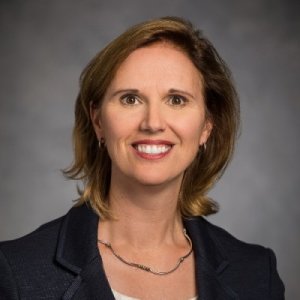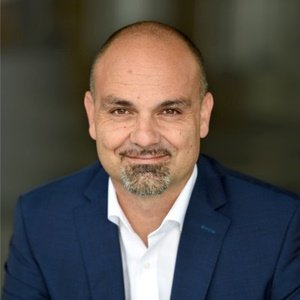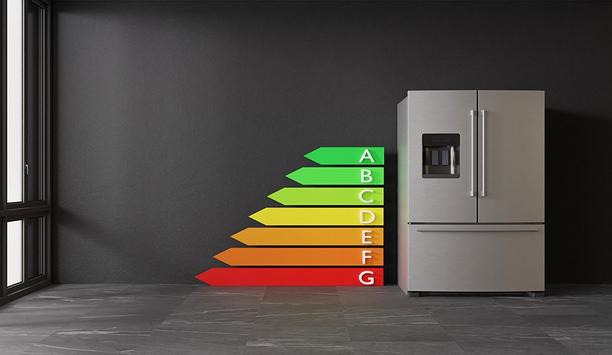Danfoss - Experts & Thought Leaders
Latest Danfoss news & announcements
Building on a successful collaboration established in 2019, Danfoss and Microsoft are expanding their partnership to accelerate the development and deployment of AI and cloud-based solutions that enable the industry to optimize energy consumption, reduce food waste, and lower emissions across food retail. Danfoss Alsense® helps supermarkets reduce food waste by up to 30%, while also reducing energy consumption on refrigeration by up to 15%. generation of sustainable solutions Danfoss Alsense is a cloud-based monitoring and management solution designed specifically for food retail businesses like supermarkets to optimize refrigeration systems. Through 24/7 monitoring, users are provided with real-time insights, enabling them to proactively minimize downtime and optimize performance, to ultimately reduce food waste and operating costs. With Danfoss’s expertise in energy-efficient technologies as a foundation and Microsoft's pioneering AI and cloud competencies as a catalyst, both are enabling a new generation of sustainable solutions for the food retail industry. Transition to a low-carbon future Integrating Microsoft's AI technology, Danfoss Alsense will become more accessible and intelligent Natalie Schnippering, Vice President of Danfoss Climate Solutions Digital Services, says: “By deepening our collaboration with Microsoft, we’re taking a significant step towards making sustainable solutions more accessible and impactful for our customers. Together, we can accelerate the global transition to a low-carbon future.” This partnership leverages AI to accelerate the achievements of shared climate goals. By integrating Microsoft's AI technology, Danfoss Alsense will become more accessible and intelligent. Together, they continue to develop and deploy joint solutions to enable faster time to market and remove barriers for customers adopting sustainable technologies. This enhanced solution will empower supermarkets to achieve greater sustainability and operational efficiency. Power of AI for a sustainable future Matt Walsh, Director Industry Advisory at Microsoft, says: "Our collaboration with Danfoss demonstrates the transformative power of AI for a sustainable future." "By leveraging AI to optimize refrigeration systems, we're helping food retailers minimize their environmental footprint. We're excited to be at the forefront of this change, empowering businesses with this transformative technology."
Danfoss Climate Solutions has named Dennis Appel as Divisional President of its newly established Controls and Thermal Management division. This new division unites the expertise of heat exchangers with refrigeration, cooling, and air conditioning technologies to accelerate innovation and enhance efficiency. Since 2020, Dennis Appel has played a key role in expanding Danfoss’ heat exchangers business. Dennis Appel to head new Danfoss Climate Solutions' division “Dennis has successfully led our heat exchangers business, and his leadership will be a tremendous asset to our refrigeration and components business. With 20 years of leadership experience in international heat transfer and thermal management companies, he brings deep industry expertise to this role,” said Kristian Strand, President of Danfoss Climate Solutions. Dennis Appel, Divisional President of the newly formed Controls and Thermal Management division, commented: “I am excited to build upon our strong foundation and history of exceptional products, solutions, and customer relationships, while bringing together two talented teams with a proven track record of success. Most importantly, I look forward to driving impactful results for our customers.” Danfoss Climate Solutions enhance customer satisfaction By combining heat exchangers and refrigeration technologies, Danfoss Climate Solutions is strengthening its ability to respond swiftly to evolving customer needs, technological advancements, and regulatory requirements. Kristian Strand, President of Danfoss Climate Solutions, said, “The HVACR industry is advancing rapidly, with an increasing focus on sustainability, energy efficiency, and compliance. Our new setup will allow us to align more effectively with these trends and seamlessly adapt to market changes.”
In 2024, sales were EUR 9,674 million. Despite challenging market conditions, they delivered a solid operational EBITA of EUR 1,097 million, equal to a margin of 11.3%. “I am especially excited to see the continuous strong performance in our Climate Solutions and our Drives businesses. We strengthened our position in selected high-growth markets like data centers, commercial heat pumps, and selected electrification applications such as marine," says Kim Fausing, President & CEO of Danfoss. Long-term growth options for Danfoss Fausing added: "Moreover, we maintained a high level of investments in innovation to expand our offerings of competitive, innovative, and best-in-class technology and solutions.” Over the past five years, they doubled the size of Danfoss, achieving balanced sales and a strong local presence across the Americas, Europe, and Asia. They firmly believe in the long-term growth opportunities for Danfoss and in offering great service to our customers all over the world. Integration of the Eaton Hydraulics Over the past five years, they doubled the size of Danfoss, achieving level sales and a strong fact This is why they continue to invest in factory automation and in regionalizing the supply chain to become more resilient. Additionally, they successfully completed the integration of the Eaton Hydraulics acquisition into the Danfoss Power Solutions segment. With the new operating model, they have decentralized further to move closer to the customers and become easier to do business with. Increasing speed in decision-making They focus on strengthening innovation and the entrepreneurial mindset as well as improving the cost competitiveness and responsiveness through increasing speed in decision-making. Now, they operate Danfoss through three segments and 16 divisions. The businesses now operate within a significantly simplified structure, supported by leaner Shared and Corporate functions. Reduction target by 2030 Sustainability is a key driver of competitiveness and an integrated part of the strategy For Danfoss, sustainability is a key driver of competitiveness and an integrated part of the strategy. They continued to decouple the organic growth from emissions, reducing the scope 1 and 2 emissions by 19% as they work toward the ambitious 90% reduction target by 2030. They also signed a power purchase agreement covering 100% green electricity for the two campuses in Haiyan, China, reducing the carbon emissions by 40,000 tons every year as of 2025, which is equivalent to 33% of Danfoss’ emissions in China and 9% globally. Green Ask initiative with strategic suppliers In 2024, they launched the ‘Green Ask’ initiative with strategic suppliers, which covers 40% of the EUR 3.5 billion spend to enhance data on sourced products and identify decarbonization opportunities. “I am proud of what the Danfoss team has accomplished together this year. Our global team’s engagement, resilience, and determination in overcoming challenges and driving impact exemplify the exceptional talent that is fueling our success." "I sincerely thank our customers and partners for their trust and close collaboration, which is fundamental for our common success going forward. While global economic uncertainties and geopolitical instability may cause market fluctuations, we stay the course. We firmly believe in the long-term growth opportunities for Danfoss,” says Kim Fausing.
Insights & Opinions from thought leaders at Danfoss
Building design and HVAC are interdependent aspects of creating a comfortable, healthy, energy-efficient, and functional indoor environment. How important is collaboration as architects and HVAC engineers seek to ensure that a building's form and function are harmonized with an efficient and effective HVAC system? We asked our Expert Panel Roundtable: How does building design impact HVAC systems – and vice versa?
The HVAC/R industry is in the process of a major shift as A2L refrigerants become the standard in residential and commercial system HVAC. This change is being propelled by stricter environmental policy and advancements in refrigeration technology. However, the transition is not without its hurdles, posing new considerations for system owners, technicians, and equipment manufacturers. Favor of GWP alternatives The Environmental Protection Agency (EPA) has established clear guidelines to phase out hydrofluorocarbons (HFCs) in favor of lower global warming potential (GWP) alternatives. The 700 GWP limit imposed by the EPA, forced manufacturers away from non-flammable A1 to mildly flammable A2L refrigerants for comfort cooling chillers and air-to-air unitary equipment. R-410A split systems Under current regulations, R-410A split systems can still be installed until January 1, 2026 Under current regulations, R-410A split systems can still be installed until January 1, 2026, but manufacturers had to halt production of R-410A-based equipment by January 1, 2025. As for packaged systems, which are fully assembled and sealed at the factory, sales will remain permitted until January 1, 2028, but only for equipment manufactured before 2025. Adaptation of A2L refrigerants These regulatory milestones mark a significant step toward a new era in HVAC/R technology, emphasizing sustainability and compliance with modern environmental standards. While the transition is underway in our market as we speak, there are some key factors that play into the adaptation of A2L refrigerants. How we implement, gain familiarity, and roll out these systems provides challenges. System Design Modifications ASHRAE Standard 15 first added these requirements in its published version of 2019 ANSI/ASHRAE Standard 15 is widely recognized as the preeminent guide for the safe use of refrigeration equipment, as evidenced by its inclusion in building codes at the state and local level. ASHRAE Standard 15 first added these requirements in its published version of 2019. For high-probability systems, in which the basic design or the location of components is such that a leakage of refrigerant from a failed connection, seal, or component could enter the occupied space, these requirements underwent major revisions for the 2022 version, with intent to better harmonize with the requirements in UL 60335-2-40. Modifications in HVAC system design The transition to A2L refrigerants necessitates modifications in HVAC system design to ensure compatibility and safety. One significant consideration is component compatibility; all system components, including compressors, heat exchangers, and expansion devices, must be rated for A2L refrigerants to ensure optimal performance and safety. Failure to use appropriate components could lead to operational inefficiencies or increased safety risks. Component Testing/Approval Requirements UL 60335-2-34 is a safety standard that applies to motor-compressors used in refrigeration systems UL 60335-2-34 is a safety standard that applies to motor-compressors used in refrigeration and air-conditioning systems. The UL 60335-2-34 6th edition was established in 2017 as the safety standard for compressors, introducing several key updates. One major change is the requirement for a new Maximum Rated Current marking, ensuring clear identification of electrical ratings. Additionally, the standard introduces various new testing methods for motors and their protective mechanisms to enhance safety and reliability. Testing methods outlined in UL 207 UL207 covers “Refrigerant-Containing Components and Accessories, Nonelectrical” which are components Danfoss refers to as “line components”, such as filter driers, expansion valves and pressure regulating valves. The testing methods outlined in UL 207 include burst pressure tests, fatigue tests, and hydrostatic tests to verify nonelectrical refrigerant-containing components and accessories. UL 207, which remains a referenced standard under UL 60335-2-40, has been reapproved for use with R-454B. Dealing with A2L refrigerants Compliance can be achieved through burst testing at five times the maximum pressure rating Unlike A1 refrigerants, where leaks at gaskets or mechanical seals were not a concern at twice the maximum pressure, such leaks now pose a significant issue when dealing with A2L refrigerants. Compliance can be achieved through burst testing at five times the maximum pressure rating or by conducting a fatigue test at three times the maximum pressure rating without the product bursting or leaking from any mechanical connection. Implementation: Choosing a Solution Understanding what makes sense for your sector of the market for this transition is paramount in how OEMs will implement (and many already have) A2Ls into the next generation of equipment. Let’s zoom in and look at the HVAC segment related to commercial A/C units. The two main A2L refrigerants that were approved via SNAP rule 26, being used to replace R-410A in the 2025 transition requirement, are R-32 and R-454B. These two offer different approaches to the design requirements needed to be implemented. R-454B Danfoss has a selection tool called Cool Selector® 2 that is free to download online While no refrigerant is a direct replacement for R-410A, R-454B which has a GWP of 466, is considered a relatively close “drop in” solution. As such, most major components of the system, such as compressors and heat exchangers, can usually stay the same size. This is the lowest GWP solution available in the “high-pressure” range. With that being said, R-454B operates at lower pressures than R-410A, it also operates at lower mass flows than R-410A. This can leave your current liquid line, liquid line solenoid, expansion device slightly oversized. It is considered good practice to verify the sizing of these existing components when introducing R454B. Danfoss has a selection tool called Cool Selector® 2 that is free to download online. This can help you in verifying Danfoss components. R-32 If the transition to A2L refrigerants is going to coincide with a major redesign of that unit, then R-32 (GWP 677) may be an option for your transition. R-32 will work at overall higher operating pressures and provide a significant increase in capacity vs R-410A. But with this comes the reality that most components in the system, possibly including piping sizes, will need to be changed to better suit the use of R32. R32 as a refrigerant, will also generate higher discharge temperatures than systems running with R-410A, creating a problem that manufacturers will need to account for in low ambient heat pumps and high condensing temperature environments. Leak Detection and Mitigation Refrigerant leak detectors must be installed in every unit with individual circuits charged with 4lbs As A2Ls pose a higher flammability risk, effective leak detection and mitigation strategies are essential for maintaining safety in environments where A2L refrigerants are used. Refrigerant leak detectors must be installed in every unit with individual circuits charged with 4lbs of A2L refrigerant or more. More details on charge limits for systems and what mitigations requirements are needed can be found in UL60335-2-40 Annex GG. These detection systems enable quick identification and response to refrigerant leaks, reducing the potential for accidents or equipment damage. Danfoss leak detectors use thermal conductivity technology, were among the first to be UL-approved a year ago and come in a variety of configurations for HVAC/R equipment manufacturers. Proper mitigation strategies Proper mitigation strategies are crucial for preventing refrigerant accumulation in case of leaks. They must be tied into the unit control scheme. Disengaging any heating elements eliminates the possibility of ignition sources. Engaging evaporator fans increases circulation, ensuring that any leaked refrigerant is quickly dispersed, minimizing the likelihood of hazardous concentrations forming. In addition, per UL60335-2-40, service and maintenance procedures must incorporate regular leak inspections as a standard practice. Refer to ASHRAE 15 or UL60335-2-40 for further readings and requirements. Service and Familiarity Technicians must gain a version of the parts of A2L refrigerants and are required to pass an A2L test While manufacturers focus on design changes to accommodate the A2L transition, industry members who will install and service units also must adjust to the changing landscape of refrigerant. Technicians must gain an understanding of the characteristics of A2L refrigerants and are required to pass an A2L certification test under EPA Section 608. Looking Forward This phase of transition is better conceptualized as a mid-term solution. The American Innovation and Manufacturing (AIM) Act was passed in 2020. This directed the EPA to address hydrofluorocarbons (HFCs) and phase down production and consumption of HFCs by 85% by 2036. It is likely in the future, we will see another step in transitions to ultra-low GWP Refrigerants such as R-290 (A3 class), R-1234ze, or R-515B. Before the AIM Act, individual states like California were looking to regulate their own refrigerant marketplaces. As adoption of new EPA regulations might be slowed under the current U.S. administration, it is uncertain if any future deregulation by the federal government could lead to some states restarting their own regulation programs. But as we stand now, lower GWP A2L refrigerants still continue to grow in the marketplace.
The HVAC Industry gathered in Orlando for AHR Expo 2025, focusing on the latest advancements in technology. Attendees included contractors, manufacturers, engineers, system design professionals, facility managers, architects, wholesalers, and distributors. This year’s expo highlighted game-changing innovations, regulatory shifts, and emerging trends designed to enhance efficiency, sustainability, and connectivity. For HVAC professionals, these developments translate into practical solutions that improve system performance, optimize energy use, and simplify compliance with evolving industry standards. The Next Phase of Refrigerant Transition The transition to A2L refrigerants is a dominant theme at this year’s expo, with major players such as Arkema, Chemours, LG Electronics, Rheem, Daikin, and others showcasing the latest refrigerants and equipment solutions. Following the deadline of Jan. 1, 2025, the shift from R-410A to R-32 and R-454B is well underway, with 80% of manufacturers opting for R-454B. While concerns about flammability persist, experts emphasize that proper training and system design can mitigate risks. LG Electronics' full product line Some OEMs opted for R-454B as an option that is closer to a “drop-in” solution Some OEMs opted for R-454B as an option that is closer to a “drop-in” solution. Daikin was among the manufacturers to go all-in on R-32, which required a complete redesign of product components, ultimately pioneering to more efficient, cost-effective systems, according to the company. LG Electronics' full product line now uses R-32 refrigerant, and they started shipping products in December. All R-410A equipment will be gone by the end of Q1. variety of products on R-454B refrigerant Rheem announced their 100-year anniversary, and a new tagline, "Engineered for Life." They say the trend is toward side-discharge heat pumps, although the industry needs a mix of both. They had a variety of products on display that use R-454B refrigerant. Attendees at AHR Expo 2025 came away with an understanding that refrigerant regulations and selecting compatible equipment will be crucial for ensuring smooth transitions in commercial and residential applications. Intelligent Building Automation and Controls Smart HVAC technology is revolutionizing building control, with AI-driven automation Smart HVAC technology is revolutionizing building management, with AI-driven automation, IoT connectivity, and remote monitoring taking center stage. Companies like Distech Controls and Schneider Electric are introducing IP-based controllers that integrate seamlessly with existing building management systems. Belimo’s intelligent butterfly valve and Delta’s Node-RED Programming with built-in Python support, among other products, are making automation more powerful and user-friendly. Copeland’s Sensi Touch 2 smart thermostat Copeland’s Sensi Touch 2 smart thermostat and Sensi equipment interface module (EIM) can eliminate the need to pull additional wires during installation. The system is weatherproof, indoor, or outdoor, and communicates using radio frequency (RF). AHR Expo 2025 made a strong case that investing in smart controls will improve operational efficiency, reduce downtime, and enable predictive maintenance. Hydronic Systems for Data Center Cooling One major player is Bell & Gossett/Xylem, whose hydronic cooling systems target data center market The rise of data center cooling solutions was another recurring theme at AHR. One prominent player is Bell & Gossett/Xylem, whose hydronic cooling systems target the data center market. The company’s e-1531X and e-1532X smart pumps offer enhanced energy efficiency and a larger "efficiency island." These systems are designed to meet the growing demand for sustainable data center cooling, providing a net-zero roadmap. As data center energy consumption rises, hydronic solutions offer a scalable, efficient approach to thermal management. Heat Pumps Expand Capabilities and Market Reach Heat pumps continue to dominate as a top energy-efficient alternative for commercial and residential applications. Companies such as Danfoss, Mitsubishi, and Samsung are pushing the boundaries with heat pumps that operate in extreme temperatures. Danfoss is progressing forward related to four application areas at AHR 2025--heat pumps, data centers, RTU/DOAS, and retail/refrigeration. Emphasis is on lower emissions and better energy efficiency. Midea drew a lot of attention at AHR 2025, including modular air handler Midea drew a lot of attention at AHR 2025, including their modular air handler – the EVOX G³ – that breaks down into three pieces for easy movement and installation in any of six configurations. They are also opening showrooms throughout the country so consumers and contractors can see and touch the products. Integration with renewable energy sources Johnson Controls-Hitachi mini-splits have a self-cleaning feature called FrostWash Johnson Controls-Hitachi Air Conditioning’s Hitachi mini-splits have a self-cleaning feature called "FrostWash;" they intentionally build a frost layer on the coil so the fine particulates can be captured and then melted away, thus avoiding mold and other contaminants. It can be used in lieu of UV light, which damages plastics. The heat pump market is growing rapidly, and advancements in low-temperature performance and integration with renewable energy sources will drive adoption. The Drive Toward Sustainability Sustainability is a recurring theme at the expo, with manufacturers prioritizing energy-efficient equipment, smart automation, and low-GWP refrigerants. Companies like Lennox, and Rheem are launching highly efficient packaged rooftop units and unitary heat pump systems. Grundfos’s distributed pumping technology and Ziehl-Abegg’s ZAcore intelligent control platform further demonstrate the industry's push toward lower energy consumption and minimal environmental impact. Investing in sustainable HVAC technologies Availability is paramount, and they are opening a new factory in Mexico Lennox is serving the "emergency replacement" market for HVAC equipment with their Xion line. Availability is paramount, and they are opening a new factory in Mexico. Telling the "story" of humidification at AHR 2025, Condair has products for any vertical. They say more education and awareness are needed on the value of humidification. As regulations tighten and demand for green building solutions rises, investing in sustainable HVAC technologies will be critical for long-term success. Smarter, Cleaner, and More Efficient AHR Expo 2025 underscores the industry's shift toward smarter, cleaner, and more efficient HVAC solutions. Whether it’s refrigerant transitions, intelligent automation, or advanced heat pump technology, staying ahead of these trends will help HVAC professionals deliver superior performance while meeting regulatory requirements. The innovations showcased in Orlando set the stage for a future where HVAC systems are not only more efficient and environmentally friendly but also easier to manage and integrate into modern buildings.
Leveraging Radiant And Hydronics To Help Achieve Decarbonization Goals
DownloadSealed Connectors In Harsh Environments
DownloadPowering And Cooling Next Generation Data Centers
DownloadDebunking Myths To Promote A Bright Future For Heat Pumps
DownloadOptimizing Comfort: The Ultimate HVAC Component Guide
Download


























































